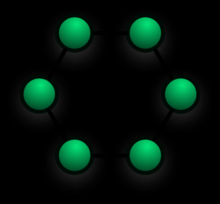Ring

-
Each node connects to exactly two other nodes, forming a single continuous pathway for signals through each node, a ring. Data travels from node to node, with each node along wthe way handling every packet.
-
Rings can be unidirectional, with all traffic travelling either clockwise or anticlockwise around the ring, or bidirectional (as in SONET/SDH).
-
Because a unidirectional ring topology provides only one pathway between any two nodes, unidirectional ring networks may be disrupted by the failure of a single link.
-
Some rings add a C-Ring (counter-rotating ring) to form a redundant topology: in the event of a break, data are wrapped back onto the complementary ring before reaching the end of the cable.
-
Some networks avoid the weakness of a ring topology altogether by actually using a start topology at the physical layer and a Media Access Unit (MAU) to imitate a ring at the data link layer.
Advantages
-
Very orderly network where every device has access to the token and the opportunity to transmit.
-
Better performance than a bus under heavy network load.
-
Does not require a central node to manage the connectivity between nodes.
-
Due to the point-to-point line configuration of devices with a device on either side, it is quite easy to install or reconfigure a device (it requires moving just two connections).
-
Easy to identify and isolate faults.
-
Ring Protection reconfiguration for line faults of bidirectional rings can be very fast.
Disadvantages
-
One malfunctioning workstation can create problems for the entire network. This can be solved by using a dual ring or a switch that closes off the break.
-
Moving, adding, and changing the devices, can affect the network.
-
Communication delay is directly proportional to the number of nodes.
-
Bandwidth is shared on all links between devices.
-
More difficult to configure than a star: node adjuntion requires ring shutdown and reconfiguration.